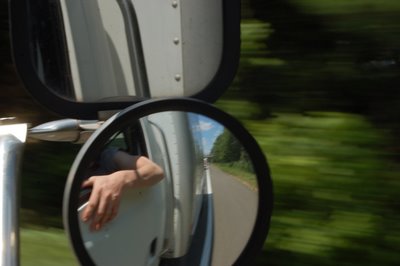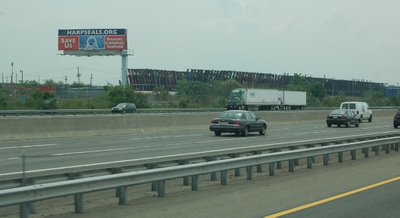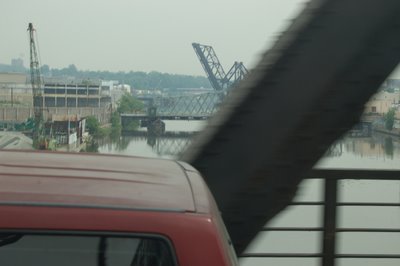Friday, June 23, 2006
Tasks
Even if somethings twenty feet in the air, it's sometimes is easier to get by hand instead of forklift. That's happening here, I'm using the largest step ladder we have. The rule is that the largest step ladder will always get me high enough so that the gap between my foothold and the ladder is just slightly larger than how far my leg can reach. That's what's going on here.

This cart has been filled with junk for months. Perhaps for the tenth time, it has been mentioned that it has been put away. I might be able to find where a few things go, but inevitably within hours someone else, walking around with a loose, strange item, will drop it onto this cart. Thus the cycle continues.

If there's nothing obvious to do, your supposed to make yourself look busy by sweeping. I tried to show how hopeless that is in this photo, but it didn't quite work. To clarify: the entire warehouse is covered in soot and dust. The floor is not smooth granite, like newer warehouses, it is old, pock filled concrete. The filth fills every pore. Any attempt to sleep only disturbs the top layer, usually just shifting it around.

Luckily vinyl siding products are durable, as we sure don't have the proper equipment to care about them.


This cart has been filled with junk for months. Perhaps for the tenth time, it has been mentioned that it has been put away. I might be able to find where a few things go, but inevitably within hours someone else, walking around with a loose, strange item, will drop it onto this cart. Thus the cycle continues.

If there's nothing obvious to do, your supposed to make yourself look busy by sweeping. I tried to show how hopeless that is in this photo, but it didn't quite work. To clarify: the entire warehouse is covered in soot and dust. The floor is not smooth granite, like newer warehouses, it is old, pock filled concrete. The filth fills every pore. Any attempt to sleep only disturbs the top layer, usually just shifting it around.

Luckily vinyl siding products are durable, as we sure don't have the proper equipment to care about them.

Some Specifics of Pulling an Order
Trying to grab something just within my reach isn't so bad, compared to the items that are 10 feet above this. The only way to get them is to stand on the forks of the forklift and ride that up to the top of the shelf. On the forklifts, there are very few warnings, but one of the specific ones is DON'T RIDE ON THE FORKS!

Here's the process of getting one item. First, it has to be found. This is no small task; at times it can take half an hour.

Next, this twelve foot long box must be pulled out of it's place. It doesn't really have a specific slot, rather, it's sorta wedged nearby where the permanent marker text states it should be.
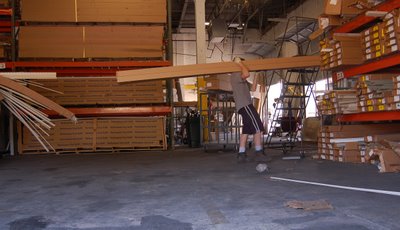
Up on the cart it goes.
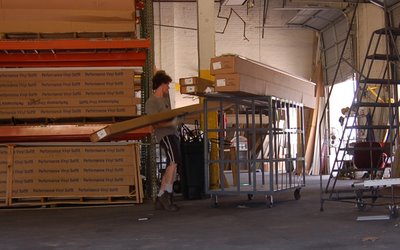
Alot of times an order won't call for the exact amount that comes in a box of an item, so it must be taken in loose peices. If that's the case, then it has to be wrapped up in cellophane so it won't be a mess.
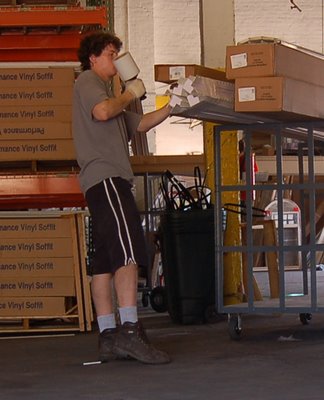

Here's the process of getting one item. First, it has to be found. This is no small task; at times it can take half an hour.

Next, this twelve foot long box must be pulled out of it's place. It doesn't really have a specific slot, rather, it's sorta wedged nearby where the permanent marker text states it should be.

Up on the cart it goes.

Alot of times an order won't call for the exact amount that comes in a box of an item, so it must be taken in loose peices. If that's the case, then it has to be wrapped up in cellophane so it won't be a mess.

Assorted Truck Pictures
A two hour drive up the New Jersey Turnpike, to drop off 10-15 windows into a small storage container. The truck can barely fit in here, it'll take about 15 minutes to back out the 1000 feet or so to the entrance. Then, a two or more hour drive back.

The combilift at rest. This machine is wonderful fun to drive- it can go forward, backwards, and sideways. All three wheels can pivot. It costs $56,000 (!), supposedly because it has a microprocessor inside that will take note of repeated driving patterns and automatize them. It is the only way to move siding around in this warehouse, as the aisles are far to narrow to carry a pallet of siding with a normal forklift.

Here's the crafty way to get a pallet of siding onto a small delivery truck- first, the green forklift picks the pallet up sideways and get it's end onto the the back of the truck. The old standard forklift then comes in and gets a hold on the end of the pallet

The green forklift drops back, and then the standard one shoves the entire pallet it. It works quite well for getting the siding in... but getting it out? The pallet must be broken apart by hand in the truck, and then hand unloaded.
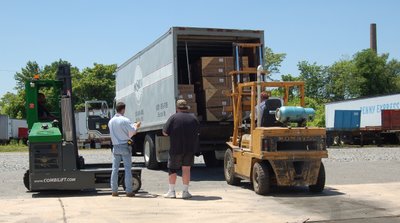
I beleive this is a very appropriate slogan.
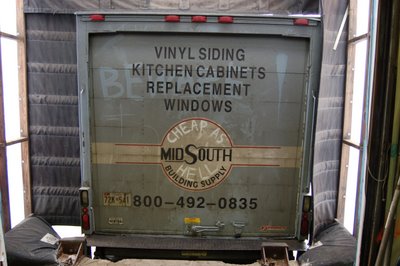

The combilift at rest. This machine is wonderful fun to drive- it can go forward, backwards, and sideways. All three wheels can pivot. It costs $56,000 (!), supposedly because it has a microprocessor inside that will take note of repeated driving patterns and automatize them. It is the only way to move siding around in this warehouse, as the aisles are far to narrow to carry a pallet of siding with a normal forklift.

Here's the crafty way to get a pallet of siding onto a small delivery truck- first, the green forklift picks the pallet up sideways and get it's end onto the the back of the truck. The old standard forklift then comes in and gets a hold on the end of the pallet

The green forklift drops back, and then the standard one shoves the entire pallet it. It works quite well for getting the siding in... but getting it out? The pallet must be broken apart by hand in the truck, and then hand unloaded.

I beleive this is a very appropriate slogan.

Scenes, From the Side Window of a Truck
Along with finance and war, scrap metal is a booming American industry. Scrap metal might be added to coal, iron, lumber, stone, etc. as a natural resource of america.

If someone came up with something that feeds off of large, empty, and weedy lots that could be a booming industry too.
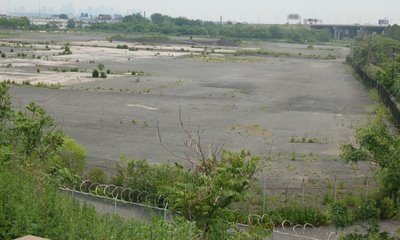

The port Newark/Elizabeth Marine Terminal says:

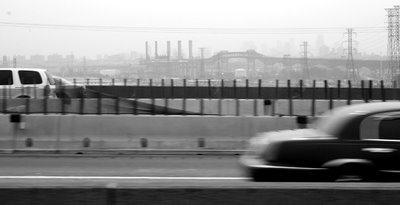

If someone came up with something that feeds off of large, empty, and weedy lots that could be a booming industry too.


The port Newark/Elizabeth Marine Terminal says:


Regularity at Work
Here's photos of some normal stuff at a building supply ware house:
Stocking fake (vinyl) shutters on a rack that is clearly not appropriate for their size.

In a warehouse, items are stored in an organized manner so that they can be found and redistributed. In the case of this warehouse, the organization is lacking, but the principle is the same. We've got about fifteen of this noisy steel carts, we wheel them around as we pick items out of stock to assemble an order. In this photo, that's already been done, and the orders on the carts are waiting to be loading onto the truck. It might be a long wait, sometimes the trucks are gone for over 12 hours in a day.

Vinyl siding, as far as I know, is usually twelve or sixteen feet long, and about a foot wide. Incredibly, 16 to 20 peices like this are simply put in a thin cardboard box, which also must be 12 or 16 feet long. Full of siding, a box also weighs perhaps 75 to 100 pounds. The boxes have no structural stability; they are like a long heavy noodle. This is what happens when you put 20 of these boxes on a long wooden pallet.
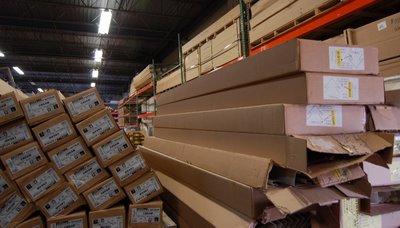
Outside, empty pallets are stacked to await pickup. (so they can be reused) In the background are the two smokestacks of a passenger railcar maunfacturer, long since abandoned.
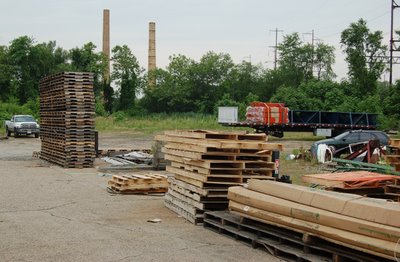
Stocking fake (vinyl) shutters on a rack that is clearly not appropriate for their size.

In a warehouse, items are stored in an organized manner so that they can be found and redistributed. In the case of this warehouse, the organization is lacking, but the principle is the same. We've got about fifteen of this noisy steel carts, we wheel them around as we pick items out of stock to assemble an order. In this photo, that's already been done, and the orders on the carts are waiting to be loading onto the truck. It might be a long wait, sometimes the trucks are gone for over 12 hours in a day.

Vinyl siding, as far as I know, is usually twelve or sixteen feet long, and about a foot wide. Incredibly, 16 to 20 peices like this are simply put in a thin cardboard box, which also must be 12 or 16 feet long. Full of siding, a box also weighs perhaps 75 to 100 pounds. The boxes have no structural stability; they are like a long heavy noodle. This is what happens when you put 20 of these boxes on a long wooden pallet.

Outside, empty pallets are stacked to await pickup. (so they can be reused) In the background are the two smokestacks of a passenger railcar maunfacturer, long since abandoned.

The Best Way to Load a Stack of Foam Onto a Cart
To use space well, foam in this warehouse is stacked to the ceiling, without the aid of machinery. It's quite tricky to stand on tall steps and try to throw bundles of this foam progressively higher; every throw threatens to throw one off balance.
To get the foam down from it's towering heights, though, merely calls for a firm tug at the bottom. Here's a sequence of that process, with an attempt to make the falling foam land on the cart it will be transported in.





To get the foam down from it's towering heights, though, merely calls for a firm tug at the bottom. Here's a sequence of that process, with an attempt to make the falling foam land on the cart it will be transported in.







